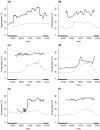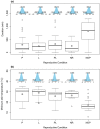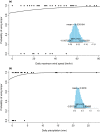Combinations of reproductive, individual, and weather effects best explain torpor patterns among female little brown bats (Myotis lucifugus)
- PMID: 31110669
- PMCID: PMC6509385
- DOI: 10.1002/ece3.5091
Combinations of reproductive, individual, and weather effects best explain torpor patterns among female little brown bats (Myotis lucifugus)
Abstract
Heterothermic mammals can use torpor, a state of metabolic suppression, to conserve energy during times of limited food and poor environmental conditions. Females may use torpor throughout gestation and lactation; however, there are associated physiological and ecological costs with potential fitness consequences. Previous studies have controlled for, but not quantified the impact of interindividual variation on torpor patterns and understanding this may provide insight on why certain thermoregulatory responses are employed. The objective of this study was to identify and quantitatively characterize the intrinsic variables and weather conditions that best explain variation in torpor patterns among individual female little brown bats, Myotis lucifugus. We used temperature-sensitive radio-transmitters affixed to females to measure skin temperature patterns of 35 individuals roosting in bat boxes in the spring and summer. We used Bayesian multi-model inference to rank a priori-selected models and variables based on their explanatory power. Reproductive condition and interindividual effects best explained torpor duration and depth, and weather best explained torpor frequency. Of the reproductive conditions, lactating females used torpor for the shortest durations and at shallower depths (i.e., smallest drop in minimum T sk), while females in early spring (i.e., not-obviously-pregnant) used torpor for the longest and deepest. Among individuals, the greatest difference in effects on duration occurred between pregnant individuals, suggesting interindividual variation within reproductive condition. Increases in precipitation and wind were associated with a higher probability of torpor use. Our results provide further support that multiple variables explain torpor patterns and highlight the importance of including individual effects when studying thermoregulatory patterns in heterothermic species.
Open research badges: This article has earned an Open Data Badge for making publicly available the digitally-shareable data necessary to reproduce the reported results. The data is available at https://doi.org/10.5061/dryad.c04tj85.
Keywords: Chiroptera; Myotis lucifugus; ecophysiology; reproduction; thermoregulation; torpor.
Conflict of interest statement
None declared.
Figures





Similar articles
-
The tradeoff between torpor use and reproduction in little brown bats (Myotis lucifugus).J Comp Physiol B. 2013 Feb;183(2):279-88. doi: 10.1007/s00360-012-0705-4. Epub 2012 Sep 13. J Comp Physiol B. 2013. PMID: 22972361
-
Effects of reproductive condition, roost microclimate, and weather patterns on summer torpor use by a vespertilionid bat.Ecol Evol. 2014 Jan;4(2):157-66. doi: 10.1002/ece3.913. Epub 2013 Dec 20. Ecol Evol. 2014. PMID: 24558571 Free PMC article.
-
Summer heterothermy in Rafinesque's big-eared bats (Corynorhinus rafinesquii) roosting in tree cavities in bottomland hardwood forests.J Comp Physiol B. 2013 Jul;183(5):709-21. doi: 10.1007/s00360-012-0728-x. Epub 2012 Dec 27. J Comp Physiol B. 2013. PMID: 23269613
-
Torpor during reproduction in mammals and birds: dealing with an energetic conundrum.Integr Comp Biol. 2014 Sep;54(3):516-32. doi: 10.1093/icb/icu093. Epub 2014 Jun 27. Integr Comp Biol. 2014. PMID: 24973362 Review.
-
Heterothermic Migration Strategies in Flying Vertebrates.Integr Comp Biol. 2023 Dec 12;63(5):1060-1074. doi: 10.1093/icb/icad053. Integr Comp Biol. 2023. PMID: 37279461 Review.
Cited by
-
Active season body mass patterns of little brown and northern myotis bats.Ecol Evol. 2022 Aug 22;12(8):e9230. doi: 10.1002/ece3.9230. eCollection 2022 Aug. Ecol Evol. 2022. PMID: 39411583 Free PMC article.
-
Thermal physiology and activity in relation to reproductive status and sex in a free-ranging semelparous marsupial.Conserv Physiol. 2019 Nov 11;7(1):coz073. doi: 10.1093/conphys/coz073. eCollection 2019. Conserv Physiol. 2019. PMID: 31737272 Free PMC article.
-
Flexible energy-saving strategies in female temperate-zone bats.J Comp Physiol B. 2022 Nov;192(6):805-814. doi: 10.1007/s00360-022-01452-7. Epub 2022 Aug 8. J Comp Physiol B. 2022. PMID: 35939092 Free PMC article.
-
Using mounting, orientation, and design to improve bat box thermodynamics in a northern temperate environment.Sci Rep. 2021 Apr 8;11(1):7728. doi: 10.1038/s41598-021-87327-3. Sci Rep. 2021. PMID: 33833318 Free PMC article.
-
Winter activity of tricolored bats in aboveground and subterranean hibernacula in the southeastern USA.Sci Rep. 2025 Apr 20;15(1):13644. doi: 10.1038/s41598-025-97703-y. Sci Rep. 2025. PMID: 40254625 Free PMC article.
References
-
- Aschoff, J. (1981). Thermal conductance in mammals and birds: Its dependence on body size and circadian phase. Comparative Biochemistry and Physiology, 69A, 611–619.
-
- Audet, D. , & Fenton, M. B. (1988). Heterothermy and the use of torpor by the bat Eptesicus fuscus (Chiroptera: Vespertilionidae): A field study. Physiological Zoology, 61, 197–204.
-
- Banfield, C. E. (1983). Climate In South G. R. (Ed.), Biogeography and Ecology of the Island of Newfoundland (pp. 37–106). Boston, MA: Dr W Junk Publishers.
-
- Barclay, R. M. R. , Kalcounis, M. C. , Crampton, L. H. , Stefan, C. , Vonhof, M. J. , Wilkinson, L. , & Brigham, R. M. (1996). Can external radiotransmitters be used to assess body temperature and torpor in bats? Journal of Mammalogy, 77, 1102–1106. 10.2307/1382791 - DOI
Associated data
LinkOut - more resources
Full Text Sources
Other Literature Sources

